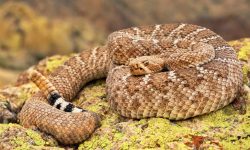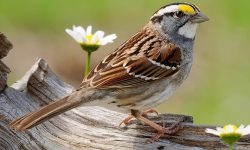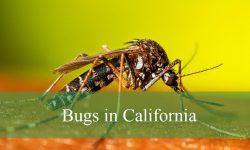There are many different types of black beetles with white spots that can be found in North America. These insects can bite or not. Certain pests, such as those that infest ornamental plants, cucumbers, and watermelons, are well-known and are typically managed with the use of pesticides or the introduction of natural predators.
These beetles are widespread in the Southwestern and Southeast regions of the United States, but they can also be found in northern settings, such as those close to the Great Lakes.
A straightforward soap and water solution works well against these prevalent black and white beetle species in North America for gardeners looking to prevent them.
Different Types of Black Beetles with White Spots
Pigweed Flea Beetle
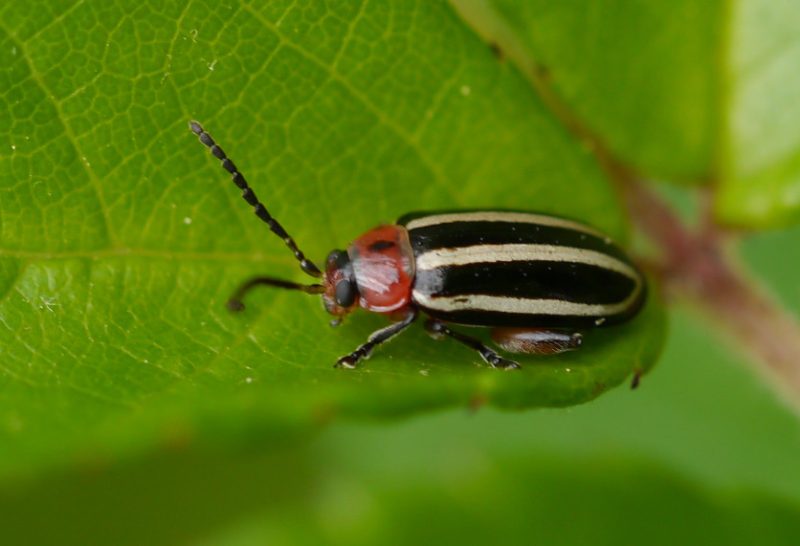
Pigweed, a major ingredient in pig diets, is the preferred food of the Pigweed Flea beetle (Disonycha glabrata), hence its name. Its body is tricolored, with a red head and alternating black-off-white stripes. Some variations have black-yellow stripes on the elytra. The elytra are usually adorned with four off-white stripes, while certain morphs have more stripes.
Cottonwood Borer
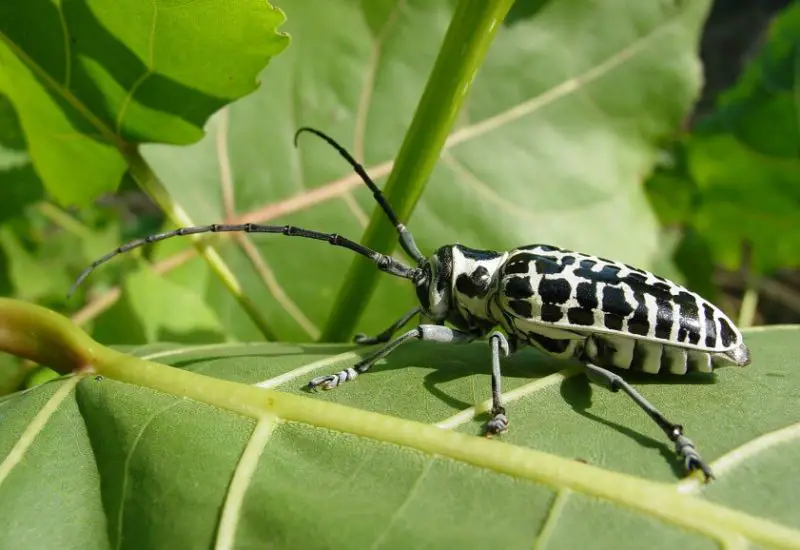
The invasive insect known as Cottonwood Borer (Plectrodera scalator) is known to feed on Balsam cottonwood trees. Its black body is embellished with sporadic white bands. This eye-catching hue resembles the patterns found in tree bark. These beetles, which have a huge body that can grow up to 40 mm, mature slowly and lay their eggs in the ground beneath the trees that they devour. Despite having a long life cycle, they finally come to life and eat tree stems, causing small damage similar to dead branches.
Texas Eyed Click Beetle
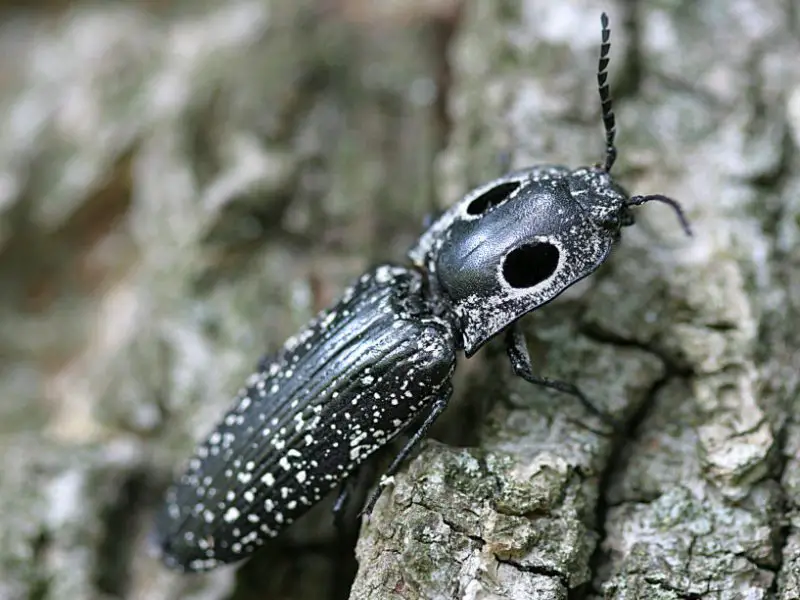
The enormous fake eyes atop its head are akin to self-mimicry used by the Texas Eyed Click beetle (Alaus lusciosus) to elude predators. It can also launch itself clear of danger via a process akin to a click. It is prevalent in Florida and other Southern states, although it is most common in Texas. Although it can bite, people are not in grave danger because the beetle cannot pierce the skin; the discomfort is just momentary.
Tumbling Ragdoll
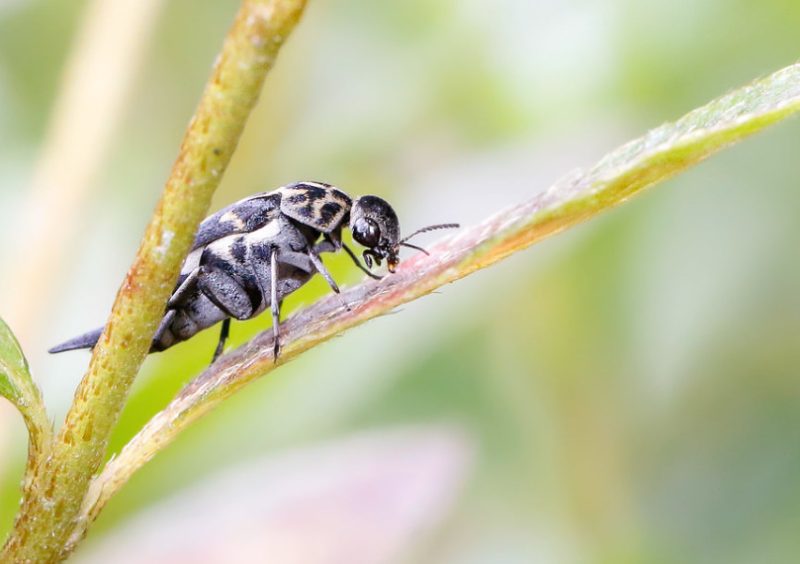
Tumbling Ragdolls (Mordella marginata) sport an elongated body with a tail-like abdomen, predominantly black with white spots and marks on the head. Various morphs, including black and red or black and brown, exist in the US. True to their name, these beetles can tumble to escape predators like wasps or birds, evading capture effectively.
Ocellated Tiger Beetle
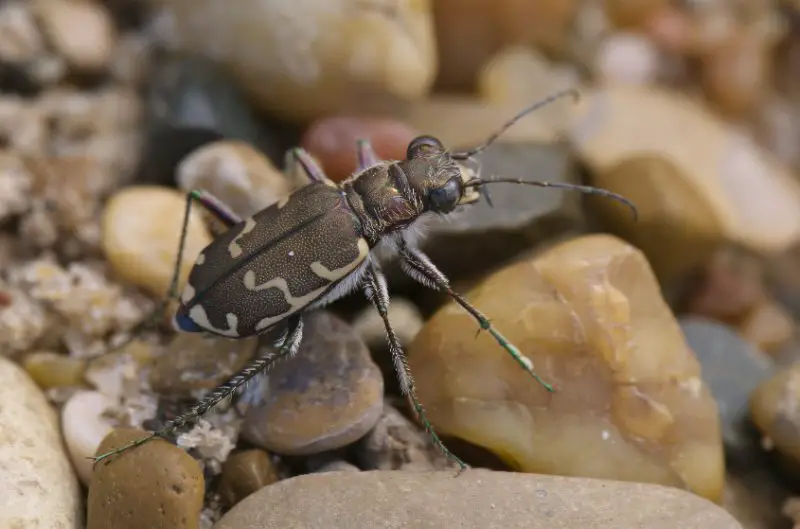
Cicindela ocellata, often known as the Ocellated Tiger beetle, is up to 13 mm in size. Known by its popular name, the Tiger beetle, it has a dark or black body with white spots. A common morph in the US has a dark green body with white patches and a black lower elytra to help with camouflage when hunting insects. Insectivorous, both adults and larvae are active day and night. They usually live near water or in sandy areas, where they make their underground nests.
Inflated Beetle
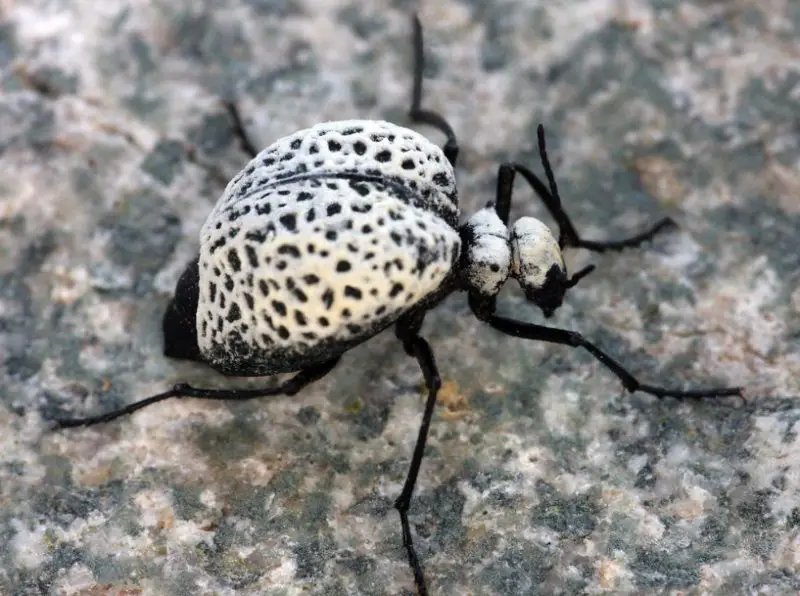
The Inflated beetle (Cysteodemus armatus) derives its name from its rounded, globular elytra. Sporting black, white, and gray coloring with hole-like textures, it features a white head. Found in the Mojave Desert, it exhibits various color variations, including black or yellow-dominant elytra. Incapable of flight, beetles of this genus crawl instead.
Banded Alder Borer
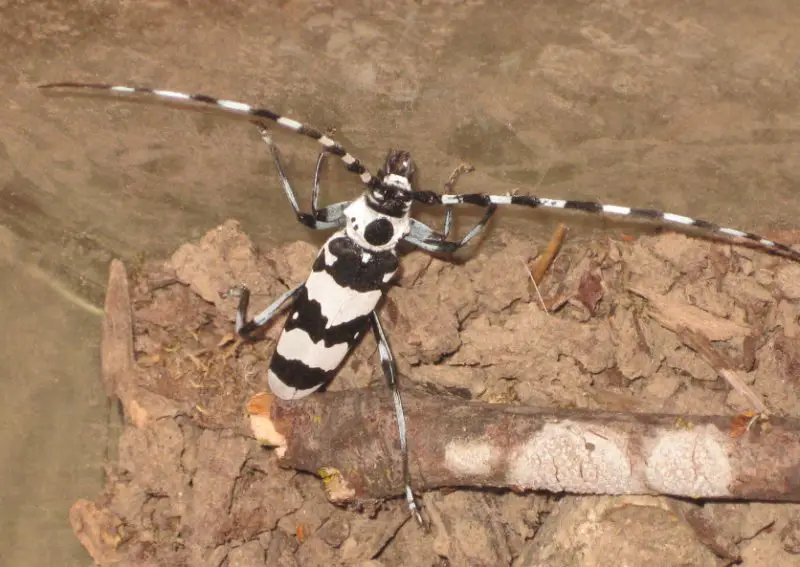
Rosalia funebris, often known as the Banded Alder Borer, is identified by its unusual black and white banded body. It can fly to avoid predators thanks to its long elytra and banded legs, however some manage to catch it. When manipulated, it produces a hissing noise. The larvae of this species feed on wood when they hatch from their eggs in the bark of trees, which may eventually stunt the growth of trees.
Hairy Rove Beetle
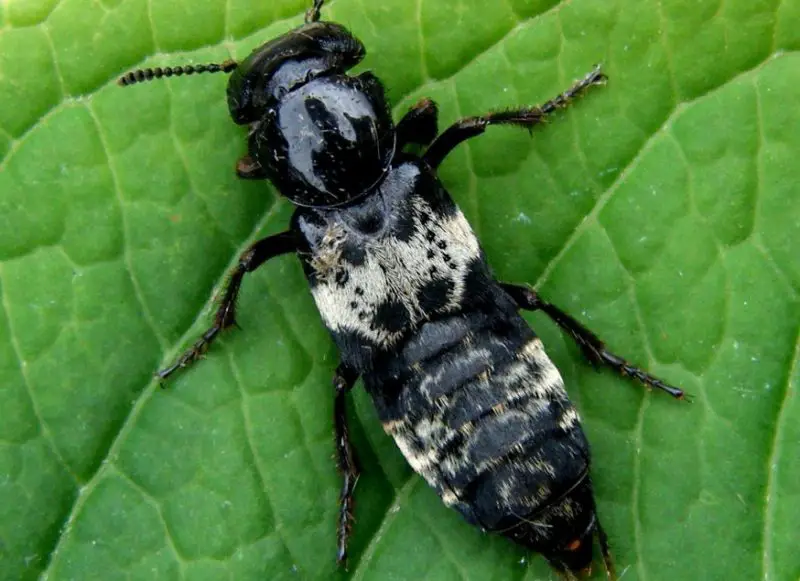
The body of the Hairy Rove beetle (Creophilus maxillosus) is black and white with alternating bands of long hair. It is common throughout the United States and can also be found in large numbers in Europe and East Asia. It has a black head and legs. They have evolved to eat other animals connected to decomposing debris, including flies, since they feed on carrion. They are frequently drawn to dead animals such as foxes or rats, although they can be seen anyplace in the United States where there is carrion.
Checkered Melon Beetle
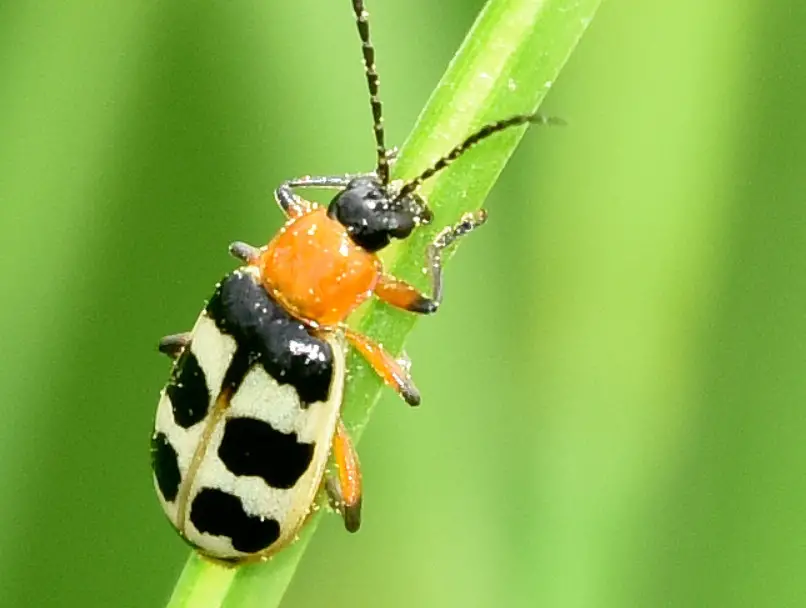
The brown heads and black and white elytra of the Checkered Melon beetle (Paranapiacaba tricincta) are accented by four black dots on each side of the elytra. These beetles are well-known pests of cucumbers and watermelon that are frequently managed by applying insecticides or importing natural predators to control their populations.
Eight-Spotted Flea Beetle
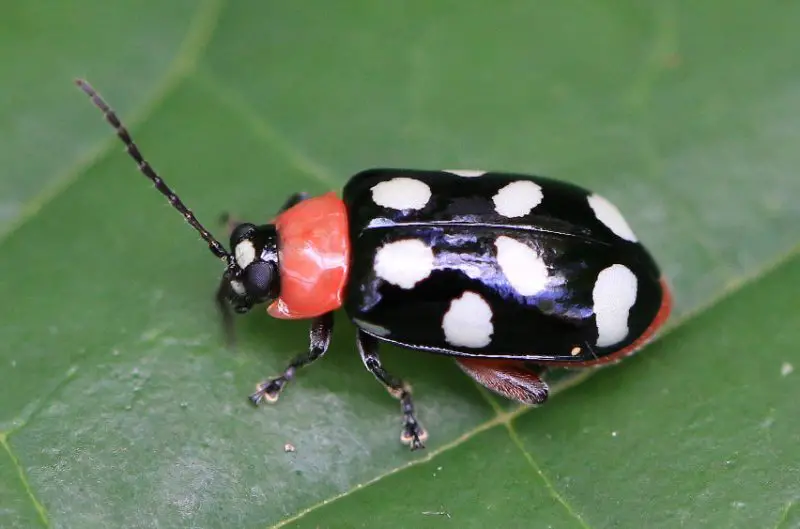
The Eight-Spotted Flea beetle (Omophoita cyanipennis) bears eight distinctive spots on its elytra, akin to the Checkered Melon beetle. With a pink-red head and black elytra marked by eight yellow spots, these diurnal creatures primarily feed on plant leaves. Commonly found in gardens, especially in Southern states, they can be both a familiar sight and a pest to green plants.
Common Asparagus Beetle
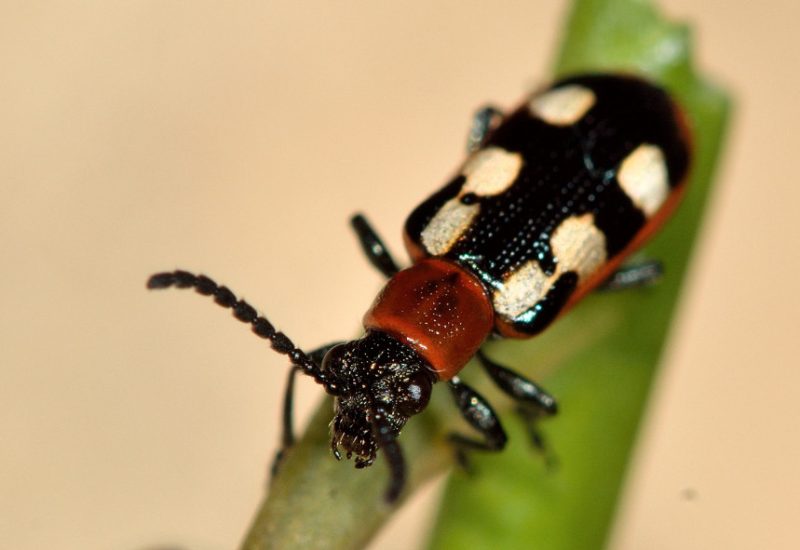
A well-known pest of asparagus, the Common Asparagus beetle (Crioceris asparagi) infests garden plantations as well as crops. These beetles, which are easily recognized by their red underbelly, thorax, and black elytra with white spots, only eat asparagus. They also inflict significant damage to plants by laying eggs and eating plant fibers. It is advised to remove them quickly by hand or with a gardening hose in order to lessen their influence. Insecticide spraying is also advised in order to safeguard crops.
Eastern Beach Tiger Beetle
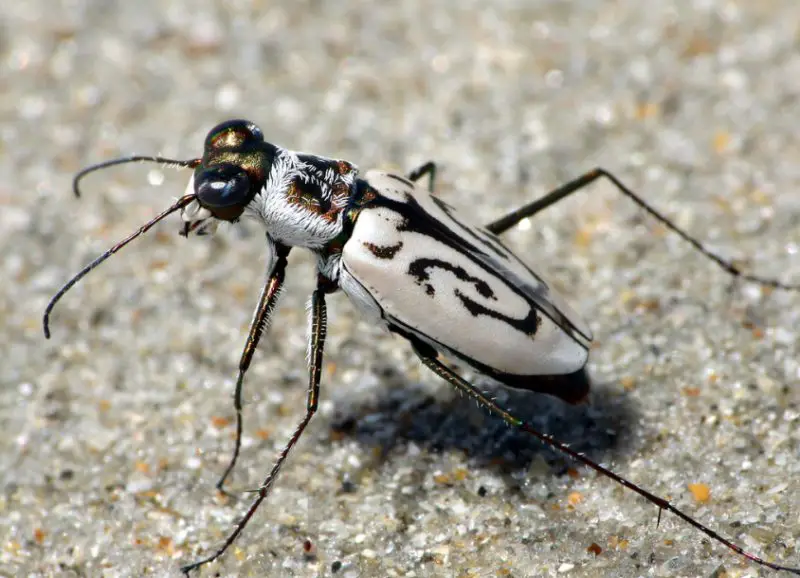
Only beaches are home to the 13–15 mm Eastern Beach Tiger beetle (Habroscelimorpha dorsalis). They have black heads and elytra that range in color from off-white to gray with black stripes. The US population is declining, and habitat destruction is to blame. Egg-laying places need to be close to water supplies, like beaches, not in deserts. Females use tiny hairs on their abdomens to measure the humidity in the sand and determine whether the habitat is suitable.
Common Willow Calligrapher Beetle
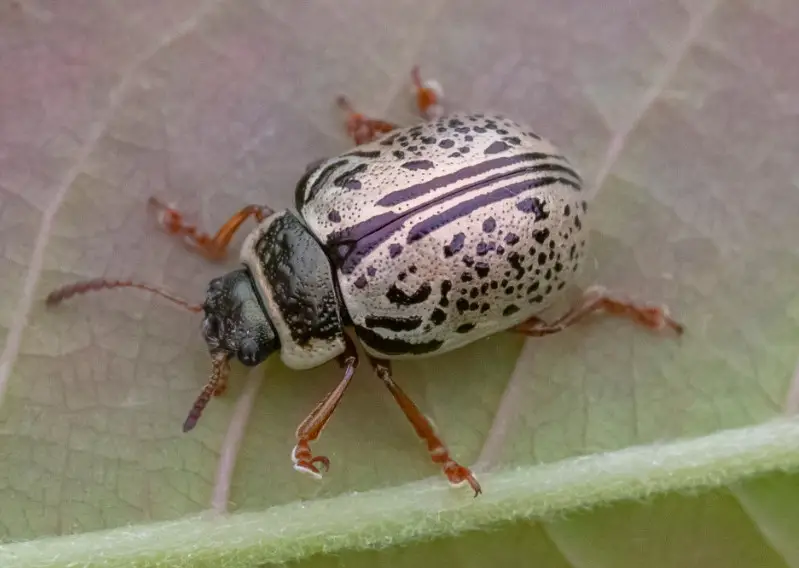
With its black and white body, the Common Willow Calligrapher beetle (Calligrapha multipunctata) resembles a ladybeetle. Their red-brown legs finish the appearance, which includes silver-white elytra with black spots and stripes, a silver-white and black head, and a thorax. Farmers control them with insecticides or by introducing natural predators like specific wasps and hoverflies. They are a nuisance in cultivated areas.
Dogwood Leaf Beetle
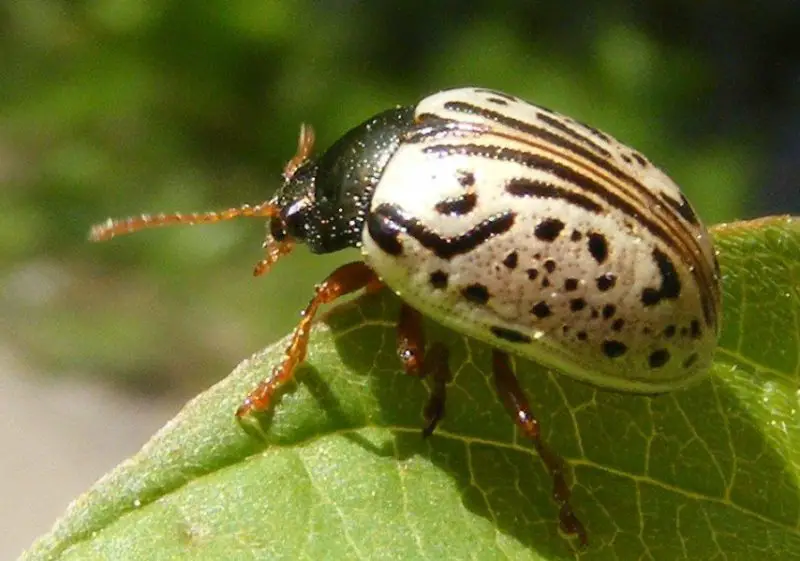
The Common Willow Calligrapher beetle and the Dogwood Leaf beetle (Calligrapha philadelphica) have many characteristics, such as a white to silver body with black spots and stripes on the elytra. They live mostly on dogwood trees, usually measuring between 7 and 9 mm, and both adults and larvae feed on the leaves of the tree. During the summer, female dogwood leaf beetles produce a large number of eggs, which guarantees high rates of reproduction for the species.
Eastern Eyed Click Beetle

The scientific name for the Eastern Eyed Click beetle is Alaus oculatus, and it gets its name from the large fake eyes that it has on its head. These big, rounded white rings strengthen its defense against predators by resembling eyeballs. Across the United States, with the exception of the South, these beetles use self-mimicry as a defense mechanism. Adults may jump or launch away from danger, and they feed on nectar, while larvae eat grubs.
American Carrion Beetle
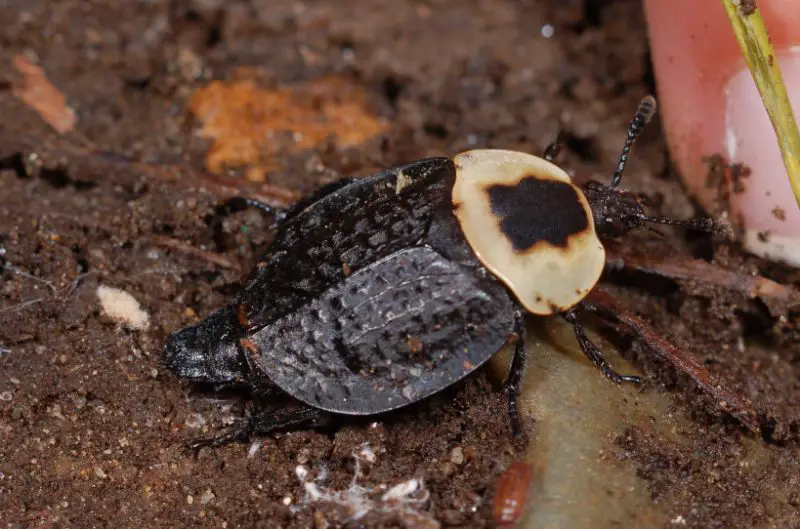
Scientifically known as Necrophila americana, the American Carrion beetle is primarily black in color, with a pale yellow or white pronotum. These beetles are skilled scavengers who thrive at consuming carcasses to reduce competition for scarce supplies. In order to lessen competition and lay eggs for subsequent generations, they eat the carcasses along with any related flies or larvae. They might hibernate underground during periods of inactivity.
Ashy Gray Lady Beetle
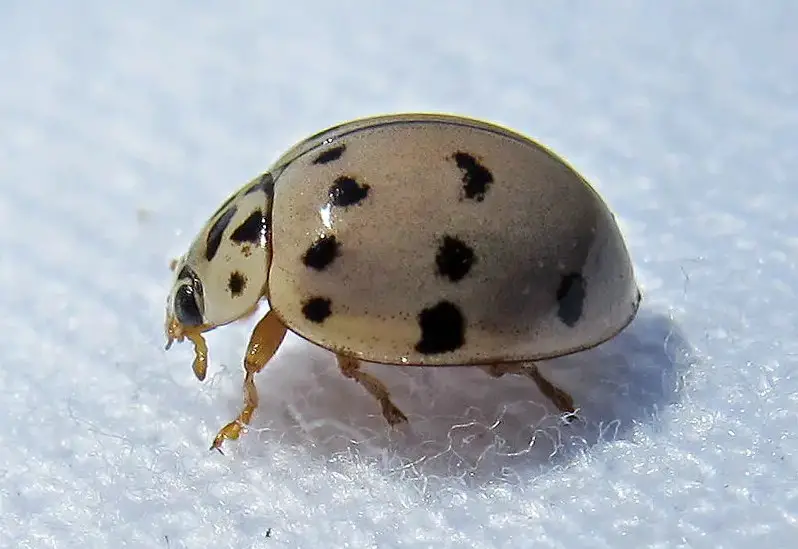
Because of its light gray color, which can often appear white, the Ashy Gray Lady beetle (Olla v-nigrum) is known for being a harmless insect. These beetles are found in large numbers in North and South America, with smaller numbers in Europe and Asia. They have an off-white elytra and a thorax with tiny black dots on it. Although there are some differences throughout the US, they all have the same light elytra hue and mostly differ in the quantity and size of spots.
Grant’s Hercules Beetle
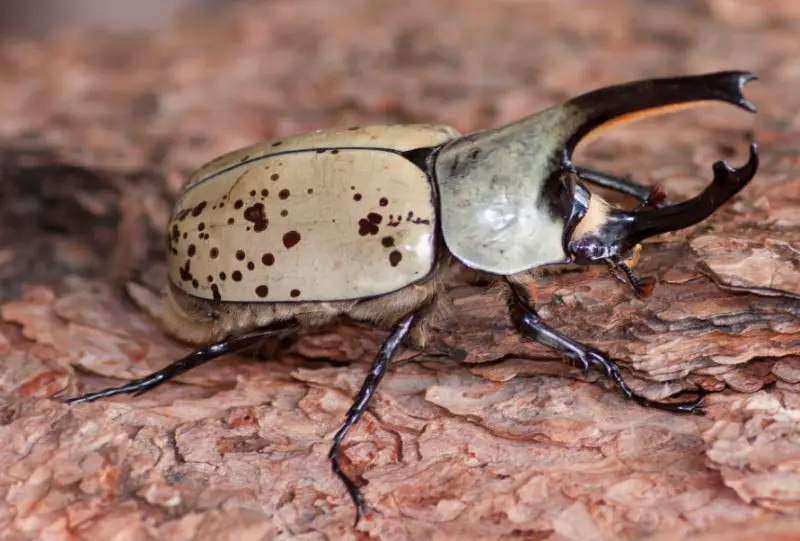
Grant’s Hercules beetles (Dynastes grantii) have a white body with black edges and tiny black dots on the thorax and elytra. Reaching up to 30mm in size, they have black legs and antennae. They feed on the bark and wood of ash trees, especially in the Southwestern US, and are thought to be damaging to them in Utah and New Mexico.
Bronzed Tiger Beetle
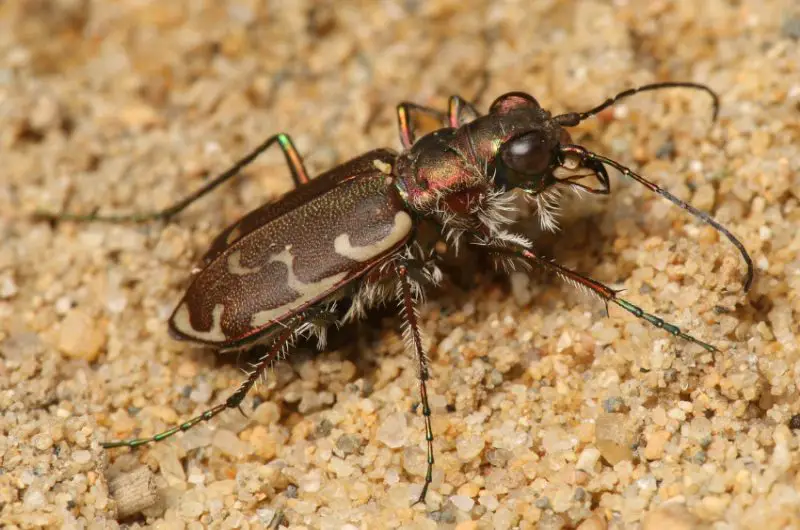
The Cicindela repanda, or Bronzed Tiger beetle, can grow to a maximum size of 13 mm. With a black head, thorax, and legs, it has a dark brown body with white markings on its elytra. It is indigenous to North America and is frequently seen in the Great Lakes region as well as other sand-filled regions of the continent.
Small-Eyed Click Beetle
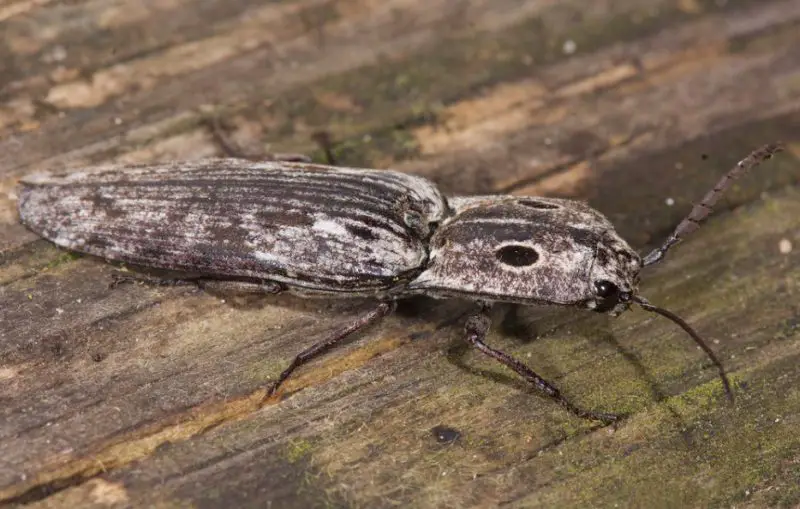
Gray, white, and black colors can be seen on the Small-eyed Click beetle (Alaus myops), which can grow to a maximum size of 38 mm. When they are adults, they mostly eat flowers because they have big artificial black eyes on their heads that they use for self-mimicry.
Twenty-Spotted Lady Beetle
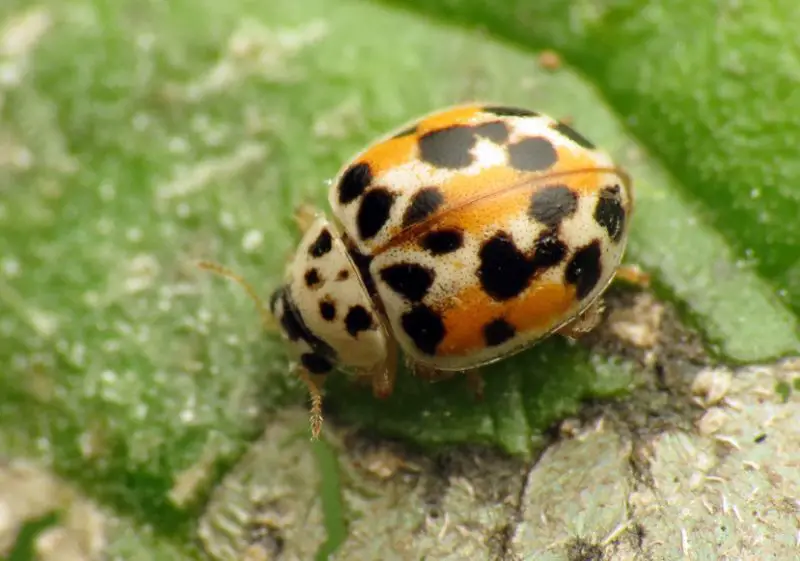
The twenty-spotted lady beetle, or Psyllobora vigintimaculata, has a small body with black spots that are surrounded by orange. They grow to a maximum size of 3 mm, making them one of North America’s tiniest black-and-white beetles. These beetles are active in the spring and feed mainly on powdery mildew and plant fungi, with a special emphasis on cabbage species. They have also been observed to consume mildew, which grows on a variety of plants and vegetables, even trees high above.
Ironclad Beetle
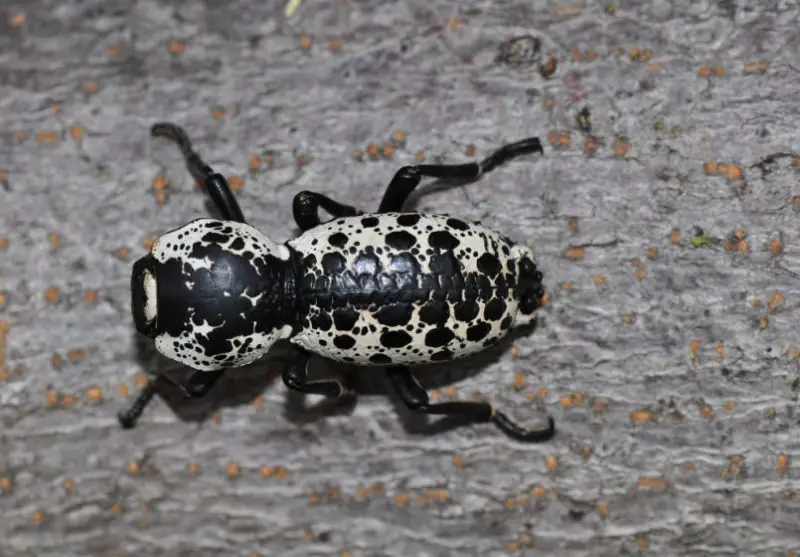
With white predominating and an erratic black line in the center flanked by black dots on either side of the elytra, the Ironclad beetle (Zopherus nodulosus) has a striking black-and-white body. Though they have not been thoroughly examined, these beetles, which are primarily found in California, are thought to be harmless pests even though they have been seen on oak trees.
Pennsylvania Flea Beetle
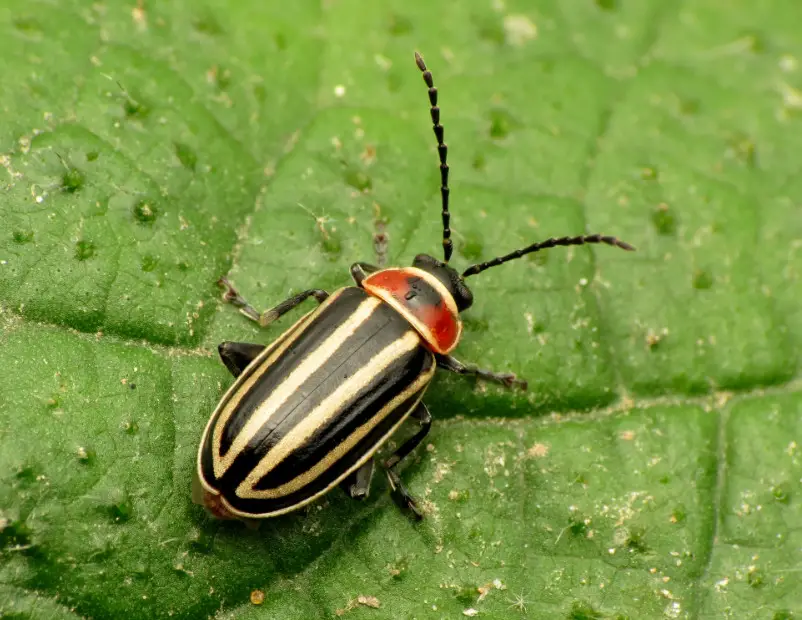
Although it prefers wetland areas close to shrubs and flowers, the Pennsylvania Flea Beetle (Disonycha pensylvanica) is not a major hazard to gardens. They feed on leaves and, given enough food, can reach a size of 6.5 mm. Their bodies are either black and white or black and off-white, and their elytra are brightly colored with four stripes. They are like fleas in that they can jump several times their physical size, making it difficult to catch them by hand.
Elm Calligrapher Beetle

Elm Calligrapher beetles (Calligrapha scalaris) reside on American elm trees, preferring to mate and feed until the tree’s health declines. With vibrant body colors ranging from off-white to dark gray, they feature three contiguous black stripes on their elytra. While their impact on American elm trees can vary, their larvae are primarily responsible for consuming entire leaves, while adults nibble on sections.
Sri Lanka Weevil
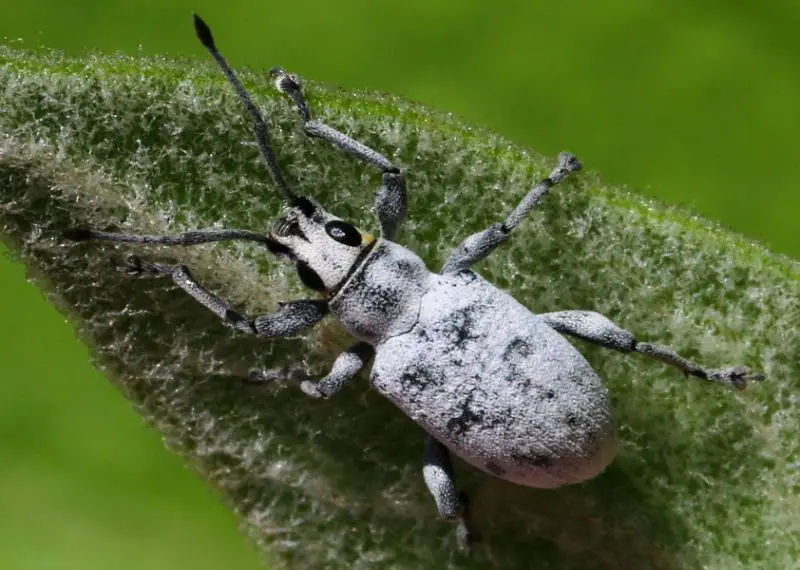
The gray head and black legs with little white portions contrast with the grayish-white body of the Sri Lanka weevil (Myllocerus undecimpustulatus), which has faded black markings. They are known to devour entire leaves on ornamental garden plants, but they stay away from crops. Weevils are skilled flyers, thus pesticides provide only a limited level of protection. Putting vinegar or soapy water directly on plants can work better, especially when they deposit their eggs in the ground, which makes removal difficult.
Milkweed Stem Weevil
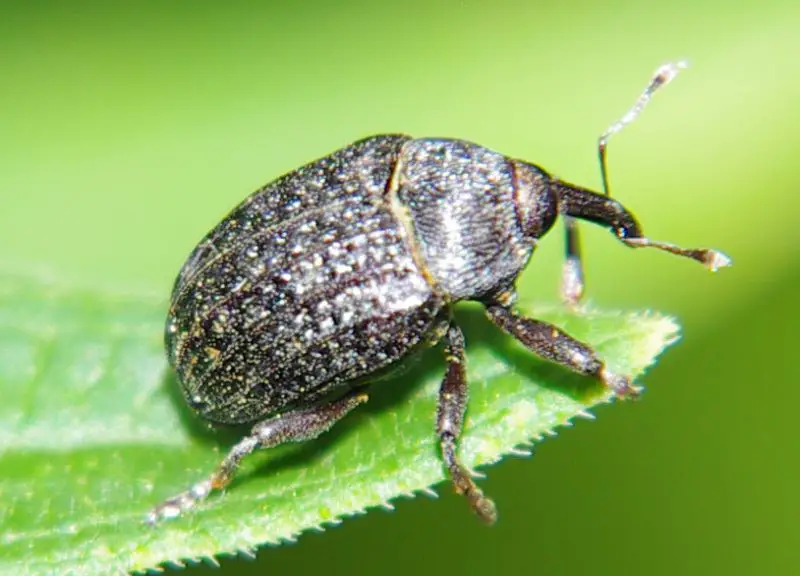
The Rhyssomatus lineaticollis, often known as the Milkweed Stem Weevil, is a plant-eating insect that eats many varieties of milkweed, including Mead’s milkweed. It is mainly black in color with slight white markings. Its effect on plant populations is exacerbated by the fact that it feeds on a variety of fruits and has striations and white-gray markings on its elytra.
Fifteen-Spotted Lady Beetle
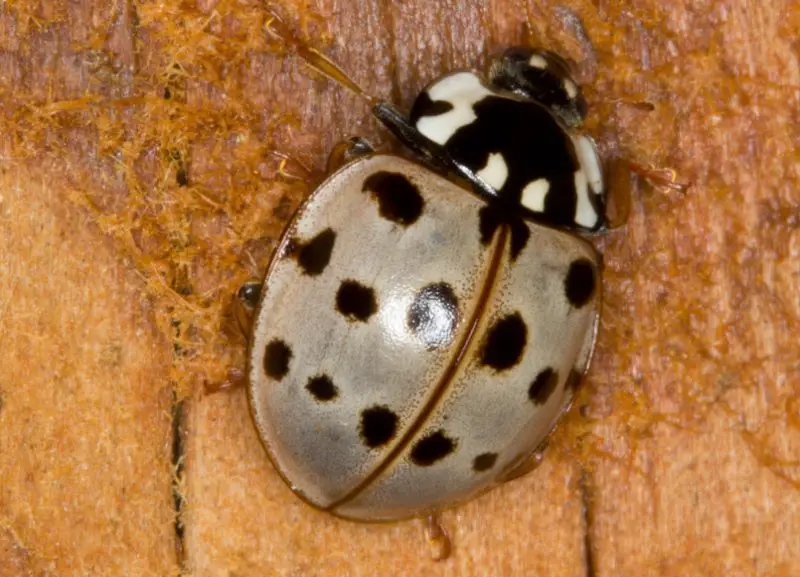
The black-spotted white body and black head of the Fifteen-Spotted Lady beetle (Anatis labiculata) are striking features. It is a little yet ferocious insect with orange antennae, legs, and elytra edges. It is essential for managing invasive pests since it feeds on scale insects and aphids.
Moustached Tiger Beetle
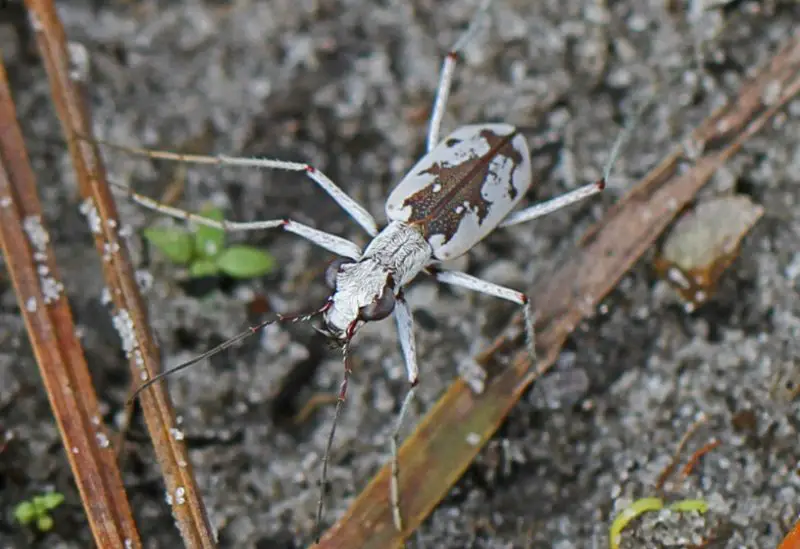
Ellipsoptera hirtilabris, often known as the Moustached Tiger beetle, is found throughout the Caribbean and North America. Its body is mostly white, with a gray and black patch on the middle elytra to help it blend in with sandy environments. Its ability to blend into its preferred habitat is aided by its colors.
Western Striped Cucumber Beetle
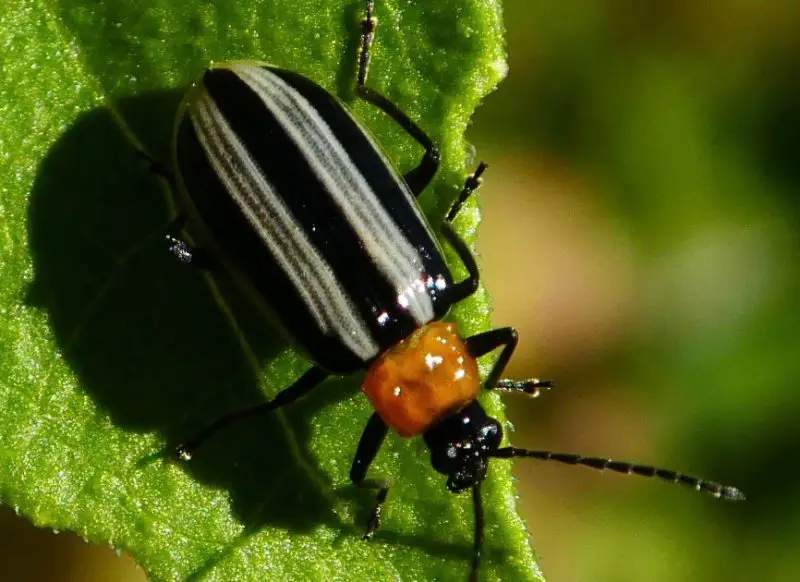
The Western Striped Cucumber beetle (Acalymma trivittatum) exhibits various color morphs, commonly black and yellow or with black and white striped elytra. With a yellow-brown head, they’re notorious for devastating cucumber crops by consuming leaves, sometimes killing entire plants. Pesticides are often employed to manage their populations and protect cucumber yields.
People Who Read This Also Read:


